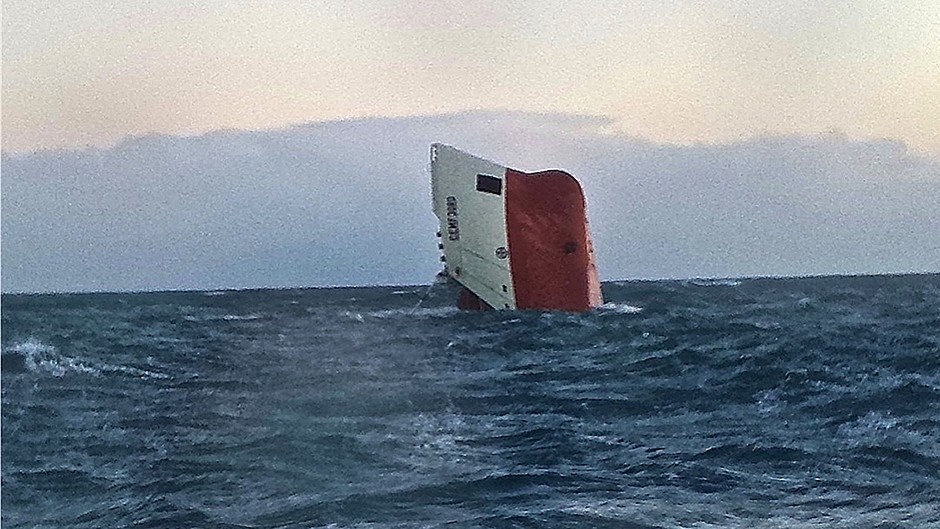Rescue efforts to find the eight-strong crew of a huge cargo ship lost off the north coast of Scotland were stood down last night with no sign of survivors.
One theory is that the boat, which was carrying thousands of tonnes of cement, may have been hit by a “rogue wave” as the area was battered by high winds.
Rescuers spoke of difficult weather conditions in the Pentland Firth on Friday when the Cemfjord was last seen.
Last night the Shetland Coastguard emergency tug, Herakles, was standing by the area of the submerged vessel.
Investigators from the Marine Accident Investigation Branch were travelling north to begin the official inquiry into the incident.
Mystery surrounds the final moments of the vessel, which did not issue a mayday when it got into difficulty.
The last recording by marine tracking devices was at 1.15pm on Friday when it was detected between the islands of Stroma and Swona, drifting at 5.2 knots, roughly 6 mph.
The Cypriot-registered cargo vessel left Aalborg in Denmark on December 30 and was heading for Runcorn, Cheshire, with a cargo of 2,000 tonnes of cement.
It was due to arrive at its destination on January 5, however, the upturned hull was spotted 11 miles off the Pentland Skerries on Saturday afternoon by the NorthLink ferry, MV Hrossey, which was heading to Aberdeen from Shetland with 241 passengers on board.
A search was launched but failed to find any trace of the eight crew, including seven Polish members and one Filipino.
The operation resumed at around 8am yesterday with lifeboat crews from Wick, Thurso, Stromness and Longhope scouring the sea, while local coastguard volunteers walked the coastlines of Caithness and Orkney.
HMS Somerset, the Shetland Coastguard helicopter and a fixed-wing aircraft also joined the efforts.
An inflatable dingy, thought to be from the Cemfjord, was found by coastguard teams on one of the Orkney islands yesterday.
The search was suspended in the afternoon, with no further discoveries.
Wick Lifeboat coxswain Ian Cormack said: “We have exhausted all the possibilities and we are running out of places to look.
“We searched from Wick up to Duncansby Head, all around the Pentland Skerries and then on South Ronaldsay to Grim Ness, but there’s just nothing.”
Mr Cormack said it was unusual that the Cemfjord’s emergency positioning indicating radio beacon had not activated. The device is meant to transmit the vessel’s position to emergency services.
He added: “It all points to a sudden catastrophic event. All I can think is that they were hit by a rogue wave.”
He said there had been 60-70mph gusts in the firth on Friday, and that in windy conditions standing waves could be created by ebb tides in a phenomenon known as the Merry Men of Mey.
Mr Cormack said: “It’s all supposition but they could have been hit by a freak wave which turned them.
“It must have been massive.”
Bill Farquhar, from the Thurso RNLI station, said the tragedy was a complete mystery.
He said: “The weather at that time yesterday was pretty, pretty, bad.
“I don’t know what happened after that and I don’t think anyone does to tell you the truth.”
The Pentland Firth is one of the UK’s busiest shipping channels and several boats could be seen passing through yesterday as the search continued.
In a statement last night, the vessel’s operators Brise of Hamburg said: “An intensive air and sea search has yet to locate the missing eight crew of the cement carrier Cemfjord, which capsized in a storm off the north coast of Scotland.
“Brise of Hamburg, the vessel managers, regret that despite the best efforts of the search teams, no trace has been found of the Cemfjord’s crew. The search has been suspended for the night.
